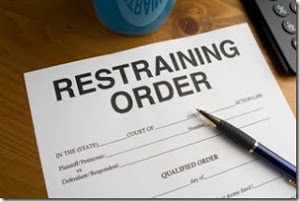How To Get A Restraining Order in North Carolina
October 21, 2014 | Domestic Violence

Restraining orders are called Domestic Violence Protective Orders (DVPOs). They are also referred to as 50B Orders in North Carolina because that is the section of the General Statutes that authorizes these specialized orders. They are intended to protect the person who filed and also serve as warning to the Defendant that they must stop the abuse and end all contact with the other party or face immediate arrest. There are 2 types of domestic violence protective orders in NC, an ex parte (temporary protective order) and a “permanent” domestic violence protective order. A temporary order can be issued immediately and without the accused present and serves as protection until there is a hearing for a permanent restraining order, which lasts for one year. To get a one-year order, there is an actual trial that allows both parties to be involved. It is a civil hearing so there is no appointed counsel for either party. The Plaintiff/victim must prove his or her case and the Defendant/accused has the opportunity to offer his or her own evidence and witnesses to defend against the allegations. At the end of the trial, the Judge decides whether to issue a permanent restraining order or simply dismiss the complaint.
Steps for obtaining a restraining order:
1. Visit the courthouse to speak with the clerk of the civil court. Tell the clerk that you want a restraining order or DVPO. They should give you a form called “Complaint and Motion for a Domestic Violence Protection Order” that you need to fill out.
2. Make sure to list yourself as the plaintiff and the abuser as the defendant. There will be a box where you should explain why you want the restraining order. Be sure to include what happened and include details like the date or time and be as specific as possible about the incident.
3. If you feel you are in immediate danger, be sure to check the box for an ex parte order, which takes effect immediately and provides up to 10 days of protection.
4. When filling out the top part of the summons, be aware that the abuser will also get a copy, so make sure the mailing address and phone number you provide are safe. An example would be to use a PO box instead of the address of the shelter where you will be staying. You also have the option in a domestic violence action to decline to put an address on the summons.
5. Do not sign the forms until the signature can be witnessed by a notary public. Usually the clerk can act as notary as well.
6. Deliver all of the forms, including “Identifying Information about the Defendant” and “Civil Summons” to your local Sheriff’s department. Someone at the Sheriff’s department will serve the defendant with the summons, complaint, notice of hearing, and ex parte order if it was granted. Providing the Sheriff’s office with contact details and a picture of the defendant will help them identify and quickly serve the forms. In the case of an ex parte order, keep in mind that the defendant has to be served before it can be enforced. You should always keep a copy of this order on you at all times and copies in places where you may be such as your car, work, or residences of friends or family.
7. Attend the hearing as scheduled by the court. Here, the plaintiff requesting a restraining order must prove that the defendant is guilty of domestic violence. The plaintiff can request that the temporary protection order be turned into a full restraining order or DVPO that can last up to one year. Failing to appear will cause your ex parte order will expire. If the defendant fails to appear, the DVPO may either be granted by the judge or the hearing may be rescheduled at the judge’s discretion.
If you have questions about domestic violence or wish to be represented by an attorney at your hearing, the Palmé Law Firm can help! Call 919-803-4512 or contact us here.